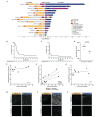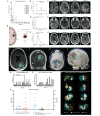Local delivery of hrBMP4 as an anticancer therapy in patients with recurrent glioblastoma: a first-in-human phase 1 dose escalation trial
- PMID: 37563568
- PMCID: PMC10413694
- DOI: 10.1186/s12943-023-01835-6
Local delivery of hrBMP4 as an anticancer therapy in patients with recurrent glioblastoma: a first-in-human phase 1 dose escalation trial
Abstract
Background: This Phase 1 study evaluates the intra- and peritumoral administration by convection enhanced delivery (CED) of human recombinant Bone Morphogenetic Protein 4 (hrBMP4) - an inhibitory regulator of cancer stem cells (CSCs) - in recurrent glioblastoma.
Methods: In a 3 + 3 dose escalation design, over four to six days, fifteen recurrent glioblastoma patients received, by CED, one of five doses of hrBMP4 ranging from 0·5 to 18 mg. Patients were followed by periodic physical, neurological, blood testing, magnetic resonance imaging (MRI) and quality of life evaluations. The primary objective of this first-in-human study was to determine the safety, dose-limiting toxicities (DLT) and maximum tolerated dose (MTD) of hrBMP4. Secondary objectives were to assess potential efficacy and systemic exposure to hrBMP4 upon intracerebral infusion.
Results: Intra- and peritumoral infusion of hrBMP4 was safe and well-tolerated. We observed no serious adverse events related to this drug. Neither MTD nor DLT were reached. Three patients had increased hrBMP4 serum levels at the end of infusion, which normalized within 4 weeks, without sign of toxicity. One patient showed partial response and two patients a complete (local) tumor response, which was maintained until the most recent follow-up, 57 and 30 months post-hrBMP4. Tumor growth was inhibited in areas permeated by hrBMP4.
Conclusion: Local delivery of hrBMP4 in and around recurring glioblastoma is safe and well-tolerated. Three patients responded to the treatment. A complete response and long-term survival occurred in two of them. This warrants further clinical studies on this novel treatment targeting glioblastoma CSCs.
Trial registration: ClinicaTrials.gov identifier: NCT02869243.
Keywords: BMP4; CED; Clinical trial; Glioblastoma.
© 2023. BioMed Central Ltd., part of Springer Nature.
Conflict of interest statement
A.L. Vescovi declares vested ownership interests in StemGen SpA and Hyperstem SA
Figures



